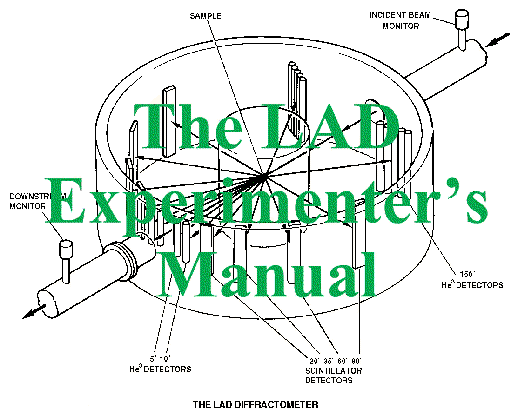
| 6.6 Furnace |
![]()
The so-called Leicester furnace is normally used as this was specifically designed for use on LAD. It is equiped with a vacuum lock and centre-stick so that samples can be changed without releasing the vacuum in the furnace, thus allowing the furnace to stay at an elevated temperature and saving a considerable amount of time. There are two thermocouples: the first is attached to the ‘pedestal’ in the furnace which locates the bottom of a sample and the second is on the centre-stick and can be adjusted to a suitable height in relation to the sample and the neutron beam.
The centre-stick for the Leicester furnace is located in a tube which can be evacuated. The centre-stick and sample may either be drawn up inside this tube or pushed down out of the tube. The mechanism for this can be stiff and care should be taken when moving the centre-stick up or down that it does not catch anywhere and damage the sample or the thermocouple. The top of the centre-stick runs along two threaded rods and these have nuts on them which can be locked in position to set a required height for the sample. A Leicester furnace mounting jig is provided to help with setting the requried centre-stick heights. One set of nuts should be set for a height where the sample is definitely withdrawn fully inside the tube. The other set of nuts should be set so that the sample is at the right height in the beam - the pointer on the mounting jig corresponds to the beam centre.
Samples can be mounted on the Leicester furnace centre-stick in two ways. Either the sample can be put inside a vanadium can with a special narrow lid fitting for use in the furnace. Or the sample can be sealed inside a silica glass tube which is then mounted inside a vanadium foil sleave. These vanadium foil sleaves are specially made at ISIS and users should consult their local contact in advance of their experiment if one is required. It is also possible to mount samples in the Leicester furnace without using the centre-stick, but instead sealing the sample inside a long silica glass tube. However, this alternative is not generally recommended since the furnace must be cooled close to room temperature when the sample is being changed and this requires a considerable amount of time.
When using the furnace it is generally best to evacuate the sample tank of air so as to minimise air scattering attenuation and background. However, it is essential that the sample tank is only be evacuated when there is already a good vacuum in the furnace - otherwise there is a high likelihood that the vacuum in the sample tank will suck off the vanadium windows on the furnace. When the furnace is in use air can be admitted to the sample tank by using the ‘fish’ key to open the electromagnetic vent (see section 3.3). A separate pump set is used to evacuate the furnace and this should be supplied with sufficient valves and connectors that it can pump on either the centre stick alone, the furnace alone, or both together.
The Leicester furnace has a maximum temperature close to 1100°C, and when higher temperatures are used it is necessary to pass cooling water through the outer part of the furnace. It should be noted that there are taps on the water supply for both the inlet and the outlet and it is essential that both taps are open if water is to flow. Note that these two taps are situated on opposite sides of the LAD services panel.
It is absolutely essential that a good vacuum of 10-4mbar or better be achieved in the furnace before heating power is applied. If heater power is applied with a higher pressure in the furnace then the element and heat shields will degrade rapidly and are likely to fail.
The sample is inserted into the furnace as follows:
i) the gate valve on top of the furnace should be closed and the valve between the furnace and the pump set also closed
ii) connect the centre stick to the furnace and attach it to the pump set (the valve should already be closed)
iii) switch off the pump set, open the valve to the centre stick and switch the pump set back on
iv) when the centre stick has reached a reasonable vacuum <10-3mbar, open the valve connecting the pump set to the furnace and the gate valve
v) the centre stick is now ready to be lowered .
The sample is removed from the furnace as follows:
i) lift the centre stick up to its top locating nuts (sample should be above the gate valve)
ii) close the gate valve and the valve connecting centre stick to pump set
iii) break the vacuum (the furnace remains under vacuum)
iv) disconnect the centre stick from the top of the furnace
The furnace temperature is monitored and controlled by the Eurotherm controller in the camac crate in the cabin. The left-hand controller (marked Hot) is connected to the power supply unit located next to the furnace via a water flow controller. The latter switches off power if the cooling supply fails. The Penning guage on the furnace pump set can be connected with a cable to the patch panel so that the vacuum reading can be displayed in the cabin.
Instructions for the computer control of the furnace temperature are given in section 6.7.8.
![]()
![]()
Last Updated 09 Nov 1998